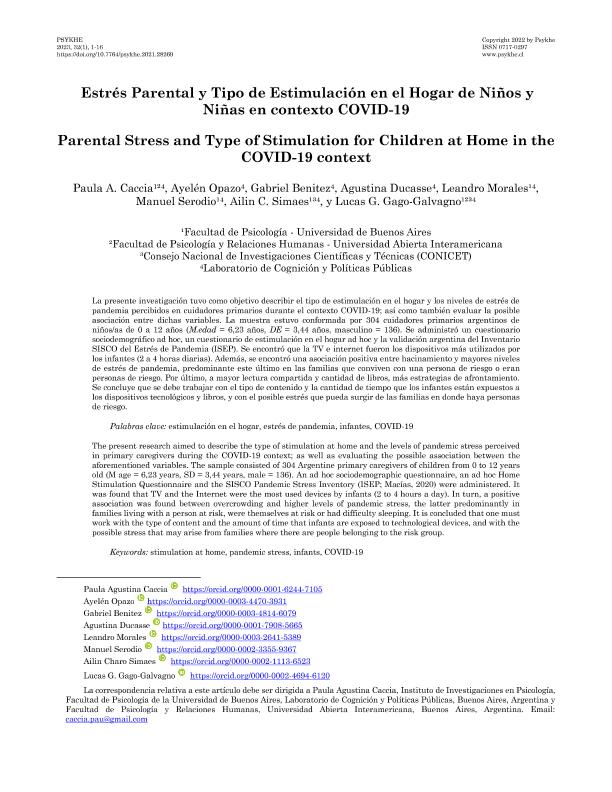Artículo
La presente investigación tuvo como objetivo describir el tipo de estimulación en el hogar y los niveles de estrés de pandemia percibidos en cuidadores primarios durante el contexto COVID-19; así como también evaluar la posible asociación entre dichas variables. La muestra estuvo conformada por 304 cuidadores primarios argentinos de niños/as de 0 a 12 años (M.edad = 6,23 años, DE = 3,44 años, masculino = 136). Se administró un cuestionario sociodemográfico ad hoc, un cuestionario de estimulación en el hogar ad hoc y la validación argentina del Inventario SISCO del Estrés de Pandemia (ISEP). Se encontró que la TV e internet fueron los dispositivos más utilizados por los infantes (2 a 4 horas diarias). Además, se encontró una asociación positiva entre hacinamiento y mayores niveles de estrés de pandemia, predominante este último en las familias que conviven con una persona de riesgo o eran personas de riesgo. Por último, a mayor lectura compartida y cantidad de libros, más estrategias de afrontamiento. Se concluye que se debe trabajar con el tipo de contenido y la cantidad de tiempo que los infantes están expuestos a los dispositivos tecnológicos y libros, y con el posible estrés que pueda surgir de las familias en donde haya personas de riesgo. The present research aimed to describe the type of stimulation at home and the levels of pandemic stress perceived in primary caregivers during the COVID-19 context; as well as evaluating the possible association between the aforementioned variables. The sample consisted of 304 Argentine primary caregivers of children from 0 to 12 years old (M age = 6,23 years, SD = 3,44 years, male = 136). An ad hoc sociodemographic questionnaire, an ad hoc Home Stimulation Questionnaire and the SISCO Pandemic Stress Inventory (ISEP; Macías, 2020) were administered. It was found that TV and the Internet were the most used devices by infants (2 to 4 hours a day). In turn, a positive association was found between overcrowding and higher levels of pandemic stress, the latter predominantly in families living with a person at risk, were themselves at risk or had difficulty sleeping. It is concluded that one must work with the type of content and the amount of time that infants are exposed to technological devices, and with the possible stress that may arise from families where there are people belonging to the risk group.
Estrés parental y tipo de estimulación en el hogar de niños y niñas en contexto COVID-19
Título:
Parental Stress and Type of Stimulation for Children at Home in the COVID-19 context
Caccia, Paula Agustina; Opazo, Ayelén; Benitez, Gabriel; Ducasse, Agustina; Morales, Leandro; Serodio, Manuel ; Simaes, Ailin Charo
; Simaes, Ailin Charo ; Gago Galvagno, Lucas Gustavo
; Gago Galvagno, Lucas Gustavo
 ; Simaes, Ailin Charo
; Simaes, Ailin Charo ; Gago Galvagno, Lucas Gustavo
; Gago Galvagno, Lucas Gustavo
Fecha de publicación:
01/2023
Editorial:
Pontificia Universidad Católica de Chile. Facultad de Ciencias Sociales
Revista:
Psykhe
ISSN:
0718-2228
Idioma:
Español
Tipo de recurso:
Artículo publicado
Clasificación temática:
Resumen
Palabras clave:
COVID-19
,
INFANTS
,
PANDEMIC STRESS
,
STIMULATION AT HOME
Archivos asociados
Licencia
Identificadores
Colecciones
Articulos(SEDE CENTRAL)
Articulos de SEDE CENTRAL
Articulos de SEDE CENTRAL
Citación
Caccia, Paula Agustina; Opazo, Ayelén; Benitez, Gabriel; Ducasse, Agustina; Morales, Leandro; et al.; Estrés parental y tipo de estimulación en el hogar de niños y niñas en contexto COVID-19; Pontificia Universidad Católica de Chile. Facultad de Ciencias Sociales; Psykhe; 32; 1; 1-2023; 1-16
Compartir
Altmétricas



